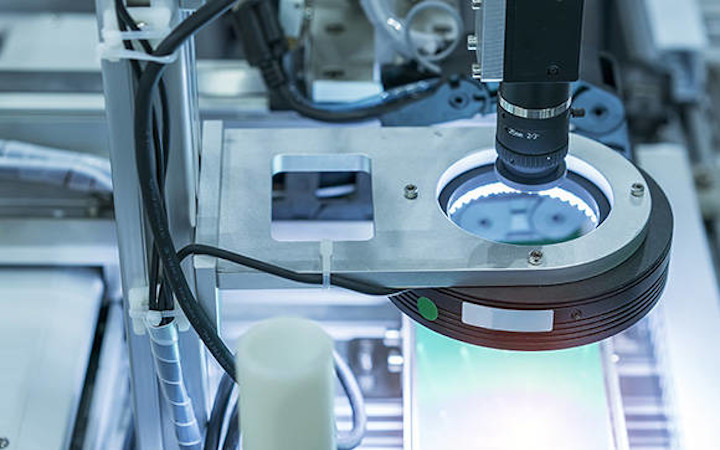Basic components of machine vision
Today, we will list the basic components needed to create a functional machine vision unit and explain their basic functionality. Machine vision mainly consists of several functional units, namely a camera system (image sensor, lens…), lighting, a data processing unit, and, last but not least, a communication module.
The lighting provides us with the illumination of the scanned object. This is a very important element of the machine vision system, as it provides us with constant lighting conditions. Light is one of the key components ensuring the reliability, quality, and stability of the entire camera system! The machine vision lens captures the image, which is sent in the form of light to the image sensor. Here, the transformation of light (received image) into digital form takes place. The vision system (central evaluation unit), the most important part of which is the CPU (central processing unit), takes care of image evaluation. The vision system can be part of the camera or as a separate unit (see the following figure).
Other components forming the functional unit of machine vision can include a control panel (touch panel / HMI), PC, or PLC that receives the processed data from the central evaluation unit for further processing and control of the production equipment. Example: The camera system captures an object and evaluates whether the object is good or bad. It sends this information via the communication module to the PLC, which ensures that in the event of a product being evaluated as Bad, the product is removed from the conveyor belt among the failures.
Lens
The machine vision lens captures the image, which then “transports” to the image sensor. It can be made in different quality, and therefore due to the quality in different price ranges. However, it is necessary to be aware of the fact that it is the lens that determines the quality and resolution of the scanned object. They also include autofocus, also known as autofocus. Image processing experts can choose the right lens based on customer requirements or otherwise based on expectations from the camera system. We can compare it to personal cameras – SLRs, where we also choose interchangeable lenses according to what we want to take pictures (whether we take pictures of nature, portraits, short-long distances, etc.).
Image sensor: Image sensor:
In addition to the machine vision lens, the image sensor also contributes to the quality of the image itself. It uses a chip capable of transforming light signals (photons) into electrical signals (electrons). As already mentioned, this is where the transformation of the image into a digital form takes place – a photo composed of a collection of pixels. Of course, the rule is that the more pixels – the more detail we can see in the created photo. It is therefore important to consider the correct choice of a camera system with the correct image sensor based on the requirements of the selected application. When undersized, this can result in incorrect -resp. Insufficient component evaluation for insufficient photo quality. When oversizing, we mainly look deeper into the wallet.
Central evaluation unit (Vision processing):
From the very name of the mentioned part of the camera system, it follows that it is a part dealing with the processing and evaluation of the digital image received from the image sensor. The said process can be implemented directly in the camera system as a part of it (embedded system) or externally in a computer (the external method is indicated in the picture above). The data processing process is a software matter, but as with the previous elements, it is necessary to consider all the possibilities and limitations of the central evaluation unit (data processing speed, software libraries, etc.) offered by a particular manufacturer when choosing your own camera system.
Communication:
As we have indicated above, camera systems can communicate with external devices for data exchange (PLC, Robot, etc.). The simplest and fastest interconnection solution is via digital inputs/outputs. When it is necessary to transmit information containing a larger amount of data, communication via communication networks and protocols (RS 232, Ethernet TCP / IP, profinet, etc.) is more suitable. However, they are usually more expensive than digital inputs/outputs, so the needs of the proposed camera system need to be carefully reconsidered.
